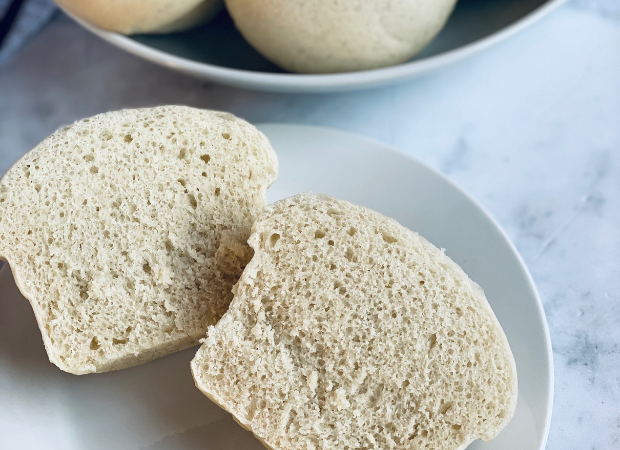Steam bread, also known as steamed bread or mantou, is a type of bread that is cooked by steaming instead of baking in an oven. It is a traditional staple in many East Asian cuisines, including Chinese, Japanese, and Korean.
Steam bread is made by combining flour, water, yeast, and sometimes sugar or salt to create a dough. The dough is then allowed to rise before being formed into small individual buns or larger loaf shapes. These buns or loaves are then placed in a steamer and cooked over boiling water, which causes the bread to rise and become soft and fluffy.
The name “mantou” is derived from Chinese, where “man” means “barbarian” and “tou” means “head.” According to a popular legend, mantou was created during the Three Kingdoms period in China when a military strategist named Zhuge Liang invented these bread rolls with a shape resembling human heads to provide sustenance for his troops.
Steam bread is commonly enjoyed on its own, served as a side dish, or used as a base for various fillings, such as meat, vegetables, or sweet bean pastes. It is a versatile bread that can be enjoyed in both savory and sweet dishes, and it is particularly popular in dim sum cuisine.
Overall, steam bread is a delicious and popular type of bread that offers a unique texture and taste due to its cooking method of steaming.

How to cook steam bread
Ingredients
- 2 cups all-purpose flour
- 1 tablespoon sugar
- 1/2 cup lukewarm water
- 1 tablespoon vegetable oil
- Pinch of salt (optional)
- 1 teaspoon instant yeast
Instructions
- In a small bowl, dissolve the sugar in lukewarm water. Sprinkle the yeast over the water and let it sit for about 5 minutes until it becomes frothy.2. In a large mixing bowl, combine the flour and salt (if using). Make a well in the center and pour in the yeast mixture and vegetable oil. Mix everything together with a spoon or your hands until a dough forms.3. Transfer the dough to a lightly floured surface and knead for about 5-7 minutes until the dough becomes smooth and elastic. If the dough is too sticky, add a little more flour; if it's too dry, add a little more water.4. Place the dough in a clean bowl and cover it with a damp cloth or plastic wrap. Let it rise in a warm place for about 1 hour or until it doubles in size.5. After the dough has risen, punch it down to release the air. Transfer the dough back to the floured surface and knead it for a minute to remove any air bubbles.6. Divide the dough into small portions and shape them into balls. You can make them as big or small as you prefer, depending on the size of the buns you want.7. Place the shaped dough balls on individual pieces of parchment paper or cabbage leaves to prevent sticking. Leave some space between each bun to allow for expansion during steaming.8. Prepare your steamer by filling it with water and bringing it to a boil. Once the water is boiling, place the buns (with the parchment paper or cabbage leaves) in the steamer basket, making sure to leave enough space between them as they will expand during cooking.9. Cover the steamer with a lid and steam the buns for about 15-20 minutes, or until they are cooked through and puffy. Avoid opening the steamer too frequently during cooking to prevent heat loss.10. Once the buns are cooked, carefully remove them from the steamer using tongs or a spatula. Let them cool for a few minutes before serving.




